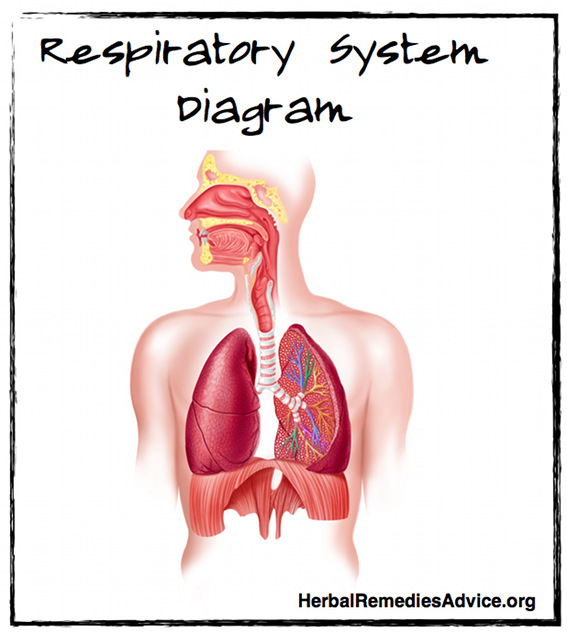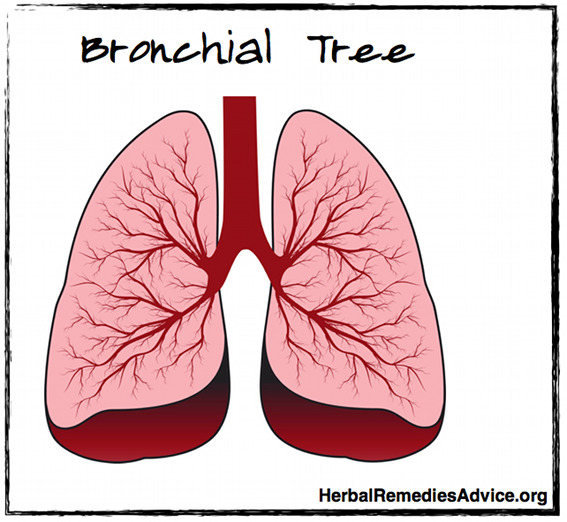Get weekly tips, recipes, and my Herbal Jumpstart e-course! Sign up for free today.

Respiratory System Overview
Share this! |
|
This article offers a brief respiratory system overview. Once we have a better understanding of how the respiratory system functions we can better understand diseases of the respiratory system and how to keep this system healthy.
The respiratory system functions play a crucial role in delivering oxygen to the cells of our body. The cells of the body require a continuous supply of oxygen; without this oxygen, we would die within minutes.
Respiratory System Overview:
The upper and lower respiratory system
The respiratory system is divided into the upper and lower respiratory tracts.
The upper respiratory system consists of the organs located above the thorax.
Organs of the respiratory system (upper tract)
- nose
- pharynx
- larynx
- part of the trachea
Organs of the respiratory system (lower tract)
- bronchial tree
- lungs
Here is a respiratory system diagram of the upper and lower respiratory system.
Respiratory System Anatomy: Upper Respiratory System Functions and Organs
This section will give you a respiratory system overview of the upper respiratory system functions.
Nose
Bones and cartilage support the protruding portion of the nose, which is made up of connective tissue and skin. The nostrils, which form two external passages, are lined with hairs that help to filter out large particles in the air. The nostrils open up into the nasal cavity. The nasal cavity is separated from the mouth by the hard and soft palettes. It is lined with ciliated columnar epithelium and cells within these structures produce mucous that line the upper respiratory system. This mucous is an important defense mechanism of our immune system as it traps airborne particles, including pathogens. The cilia move the mucous with the entrapped particles to the throat where it is swallowed. Gastric juices from the stomach then kill most micro-organisms.
The mucous in the nasal cavity also moistens air as it moves through the nasal passageways. The mucous membranes are blood rich and serve to warm the inhaled air. In this way, air traveling through the nasal passageways are filtered, warmed, and moistened before heading to the lungs.
Several bones that surround the nasal cavity contain air-filled hollow areas called paranasal sinuses. Sinuses in this area increase voice resonance. They are also lined with the same ciliated mucous membranes found within the nasal cavity.
Pharynx
More commonly called the throat, the pharynx is a short tube that extends from behind the nasal cavity to the larynx and esophagus. It is a muscular wall that is lined with mucosal tissue. The tonsils, which contribute to the immune system, are located within the pharynx.
Larynx
The larynx consists of cartilaginous tissues. It connects the pharynx to the trachea and the esophagus. The larynx houses the vocal chords whose vibrations produce the sounds of speech.
When swallowing, muscles lift the larynx, which causes the epiglottis to fold over and cover the opening to the trachea, which leads to the lungs. If food, water, or other particles somehow breach the trachea, a strong coughing reflex is produced that will expel the materials.
Trachea
The trachea, commonly known as the windpipe, is a tube that connects the larynx to the bronchial tree and allows for inhaled air to proceed to the lungs and exhaled air to leave the body. Cartilaginous rings support the trachea and hold it open despite the changing air pressure within this tube.
The trachea is lined with the same ciliated mucous membranes that we find in the rest of the respiratory system. It also traps airborne particles and then transports the mucous upwards towards the pharynx where it is swallowed and proceeds to go down the esophagus.
The trachea splits into two sections at about the mid-chest to form the left and right primary bronchi.
Respiratory System Anatomy:
The Lower Respiratory System Functions
This section will give you a respiratory system overview of the lower respiratory system functions.
Bronchial Tree
The term bronchial tree refers to a series of structures within the lungs that actually resembles a tree! I find this incredibly fascinating. Trees transform CO2 into oxygen. Humans transform oxygen to CO2, and the human organ for performing this process looks like a tree!
The left and right primary bronchi further branch to form smaller secondary bronchi. There is a secondary bronchi in each lobe of the lung. These secondary bronchi continue to branch into smaller and smaller tubules.
As these branches become tubules they are called bronchioles.
Bronchioles continue to branch until finally leading to microscopic alveolar ducts that then terminate in alveoli. Back to our image of a tree, the primary bronchi is similar to the trunk of a tree, the secondary bronchi are the main branches, which then become smaller branches and, finally, leaves.
There are 300 million alveoli in each lung. They resemble a grape cluster on a vine and have a surface area of 75 square meters. A capillary network surrounds each alveolus.
The alveoli perform the magical task of infusing blood with oxygen, while removing excess CO2 from the body. This chemical process takes place between the alveoli membranes and the rich capillary network that surround them.
Lungs
The lungs are two large organs that fill much of the rib cage. The right lung is slightly larger than the left and is made up of three lobes. The smaller left lung is made up of two lobes.
The lungs are primarily made up of connective tissue, which gives them their soft and spongy texture. They also consist of blood, lymphatic tissue, air passageways, and alveoli.
Physiology of the Respiratory System Overview
All of the organs of the respiratory system work together to create breath. Breath is essentially the physiology of the respiratory system.
Breathing
Here’s an overview of the breathing process.
Air is inhaled through the nose and or mouth and travels down a series of tubes including the pharynx and trachea until it reaches the bronchi and finally down to the microscopic aveloi.
At the membrane surface of each alveolus, a gas exchange between oxygen and CO2 takes place. The oxygen enters in the blood stream and binds to red blood cells while the CO2 is expelled back out of the respiratory system and exhaled into the atmosphere.
Inspiration – The act of inhalation
We breathe about 5,000 times a day or about 15 to 20 times each minute. With each inhalation the muscles of respiration contract. When the diaphragm -a flat skeletal muscle tissue at the base of the rib cage- contracts, it flattens and creates more space in the thoracic cavity for the lungs to expand. Concurrently, the external intercostals elevate the ribs and sternum, creating even more space for lung expansion.
This expansion of the lungs increases the volume of internal air passageways, which then means that the air pressure inside the lungs decreases below the air pressure of the air outside the body. This change in air pressure causes the atmospheric air to rush into the lungs, because gas likes to move from regions of high pressure to low pressure.
Expiration – The act of exhaling
With each exhalation the diaphragm and external intercostal muscles relax. This causes the elastic fibers in lung tissue to recoil to their original volume. Air pressure is now reversed and so the air rushes out. During times of rapid breathing such as exercising, exhaling is further facilitated by the intercostals muscles and the abdominal muscles contracting.
When we draw in a breath, we share that air with all other human beings and all other life on our planet. Through respiration, our oneness with trees becomes a manifest fact, and our communion with the oceans has immediate impact. The reality of the planetary whole reveals itself, with implication for all human life, through the circulation of the gases and energy of the atmosphere. This vision underlies holistic healing as much as it does ecology. The anatomy and physiology of the respiratory system is a complex and beautiful embodiment of integration and wholeness.
-David Hoffman, Herbalist
Summary
The respiratory system gives us the crucial ability to breath. The system is anatomically divided into two different sections: the upper respiratory system and the lower respiratory system. Together these organs help us perform the act of inspiration and exhalation.
Did you enjoy this respiratory system overview? Are you interested in keeping your respiratory system healthy? See my 7 Tips for a Health Respiratory System here.

Rosalee is an herbalist and author of the bestselling book Alchemy of Herbs: Transform Everyday Ingredients Into Foods & Remedies That Healand co-author of the bestselling book Wild Remedies: How to Forage Healing Foods and Craft Your Own Herbal Medicine. She's a registered herbalist with the American Herbalist Guild and has taught thousands of students through her online courses. Read about how Rosalee went from having a terminal illness to being a bestselling author in her full story here.

